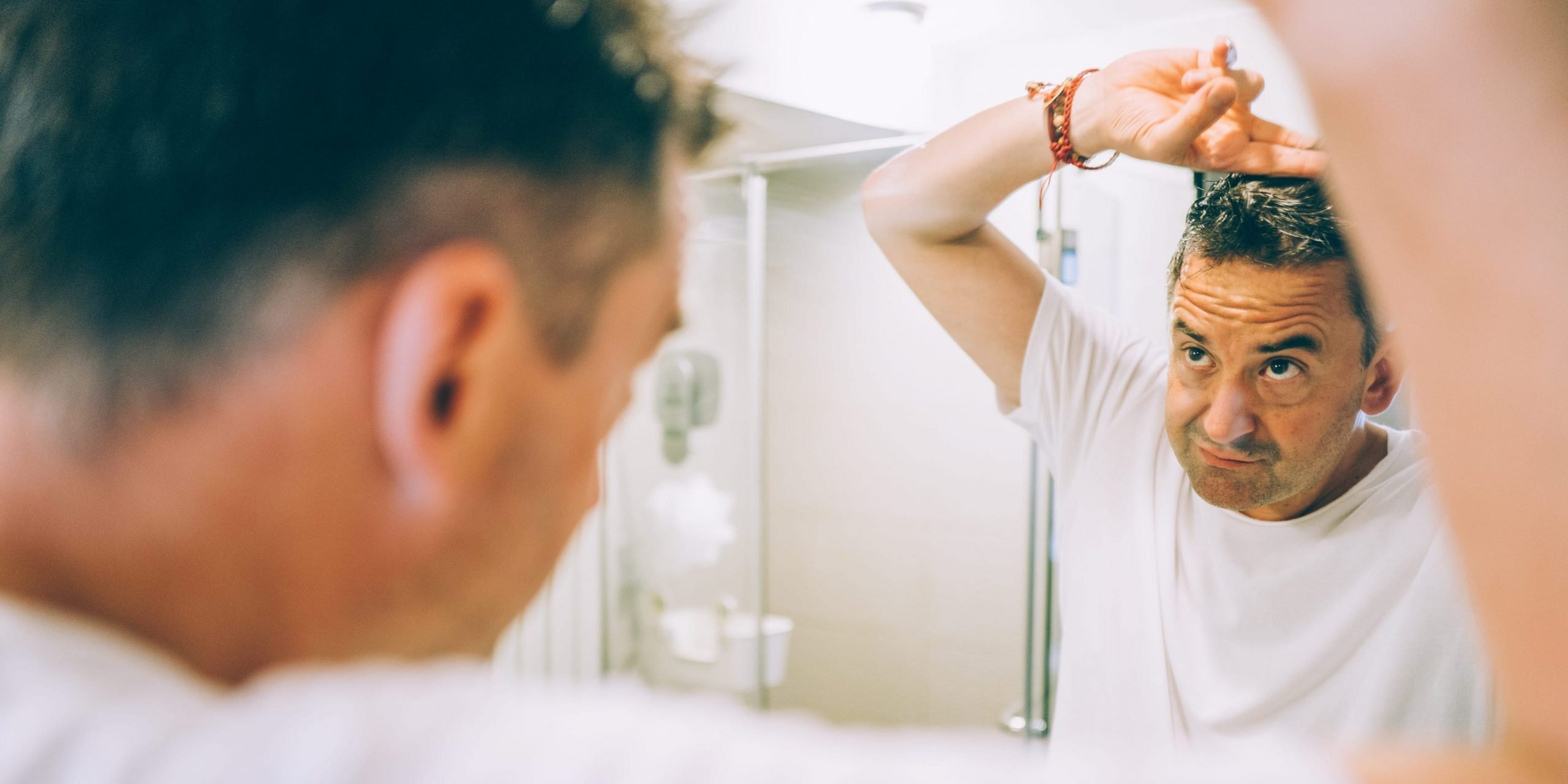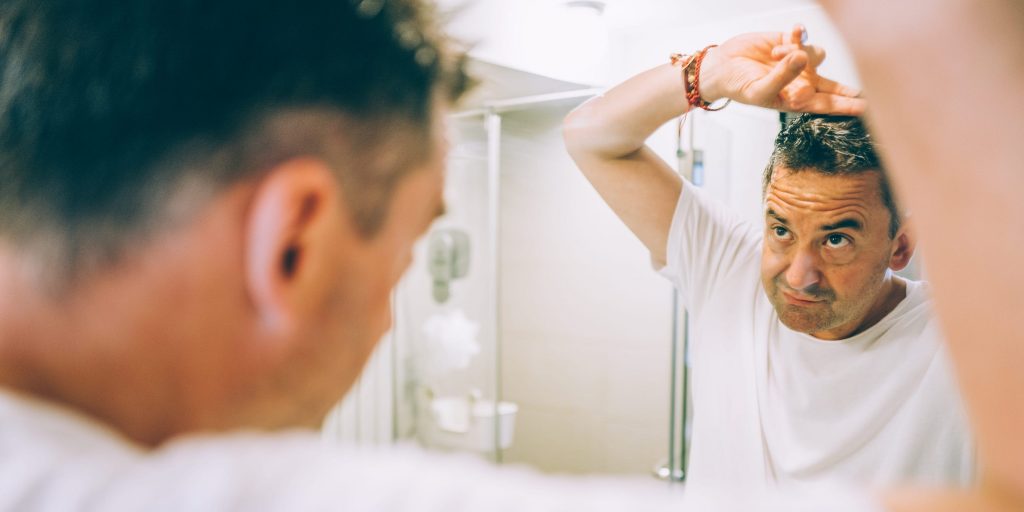
- Male pattern baldness is inevitable for some and can start early before you even turn 21.
- Medication, laser therapy, and hair transplants can help you regrow some of that lost hair.
- Not all of your hair will grow back, but you may get some of it back with proper treatment.
- Visit Insider's Health Reference library for more advice.
Male pattern baldness — or androgenetic alopecia — accounts for more than 95% of hair loss in men, making it the most common type of hair loss. About 25% of men who suffer from it will start losing hair before the age of 21.
The condition is not harmful to your health, and treatment is unnecessary if you are content with your appearance. Moreover, there's no way to prevent hair loss, but some medicines can slow it down.
Here's what you need to know about the causes, symptoms, and treatment for male pattern baldness.
Causes
There are plenty of factors at play when it comes to male pattern baldness, such as:
- Genetics: Those who develop male pattern baldness are predisposed to it by the genes they inherit, says Brett King, MD, PhD, Yale Medicine dermatologist and associate professor of dermatology at the Yale School of Medicine. Heredity accounts for about 80% of the predisposition to male pattern baldness.
- Hormones: The hair follicles of a balding scalp are found to have higher levels of dihydrotestosterone (DHT), a type of male sex hormone, than a non-balding scalp. Excess testosterone production leads to high levels of DHT, and the hormone causes hair follicles to miniaturize or shrink, which results in baldness.
- Age: Hair growth slows over time and hair follicles stop growing hair, so the prevalence and severity of male pattern baldness naturally increase with age. The average age of onset is mid-20s, and at least 50% of white men have male pattern baldness by the time they reach age 50.
- Race: White men are more likely to develop male pattern baldness — and the hair loss is often more extensive — than men of Asian, Native American, and African descent.
Male pattern baldness occurs when hair follicles shrink in size, causing thinner hair and shorter growth cycles. Eventually, the follicles will no longer produce hair, says Susan Massick, MD, a dermatologist at the Ohio State University Wexner Medical Center and associate professor of dermatology in the Ohio State College of Medicine.
Symptoms
The hair loss itself due to male pattern baldness is asymptomatic and there's no associated itching, discomfort, or pain, says Massick.
The way you'll notice if you have it is a receding hairline or thinning hair on the top of the head. This can progress to partial or complete baldness, but the rate of hair loss is different for everyone.
"Hair loss does not progress at the same rate in everybody and some males will have relatively rapid progress of hair loss, for example, over a decade or less, while others will have relatively mild hair loss that is stable for a decade or longer," says King.
Treatment
"Male pattern baldness can't necessarily be prevented and you can't stop the inevitable, but you can slow it down," says Massick. "Successful treatment options are available and safe to use, but must be started early on to preserve as much hair as possible."
It's also important to note that male pattern baldness is not a sign of a medical disorder, but it can lower self-esteem and impair the quality of life. If you are not bothered by it, there is no reason to treat it, says King.
If, however, you do want to treat male pattern baldness, get in touch with a dermatologist to discuss your treatment options. Two FDA-approved medicines are generally recommended as the first-line treatments:
| Medicine | Type | Brands | Usage | Effect | Results |
| Topical minoxidil | Over-the-counter | Rogaine | A solution applied to the scalp twice a day | Reduce hair loss, strengthen existing strands of hair, and stimulate hair growth | Up to six months to see results |
| Oral finasteride | Prescription | Propecia, Proscar | A pill taken every day | Slow down hair loss in 80% to 90% of men and stimulate hair regrowth | Up to six months to see results |
It's important to note that both of these medicines won't work the same way for everybody.
"The results of taking these medicines are uncommonly dramatic and neither of these medicines should be expected to yield substantial hair regrowth in most males," says King. "When a treatment is effective and hair regrows, stopping that treatment will result in loss of regrown hair over a period of months."
Other possible treatments include the following:
- Light or laser therapy, a procedure that emits a light to penetrate the scalp and stimulate hair follicles to grow hair. However, "the vast majority of males who undertake this treatment will not experience visibly remarkable hair regrowth," says King.
- Oral minoxidil, a medication that is shown to be safe and effective in increasing hair growth. It is not recommended for people with an increased risk of heart failure, heart attack, or severe hypertension.
- Platelet-rich plasma (PRP), a procedure where doctors draw your blood and inject plasma into the scalp to promote cell growth. "The medical literature, however, offers very little high quality evidence in support of PRP and there are several studies that show no benefit at all," says King.
- Wearing hair transplants, wigs, or hats, which physically alters your appearance, are common ways to manage hair loss as well.
Insider's takeaway
Male pattern baldness is caused by a number of factors such as genetics, hormones, and age. It usually starts with thinning hair on the hairline or top of the head, which eventually progresses to partial or complete baldness.
Although there's no way to prevent hair loss, some treatment options can slow it down and potentially stimulate some hair regrowth, but don't expect all of it to grow back.
"Talk to a board-certified dermatologist as soon as you start noticing hair thinning, if hair loss is bothersome or concerning to you," says Massick. "Treatment with medicines can be effective if started early, used consistently, and continued long-term."
